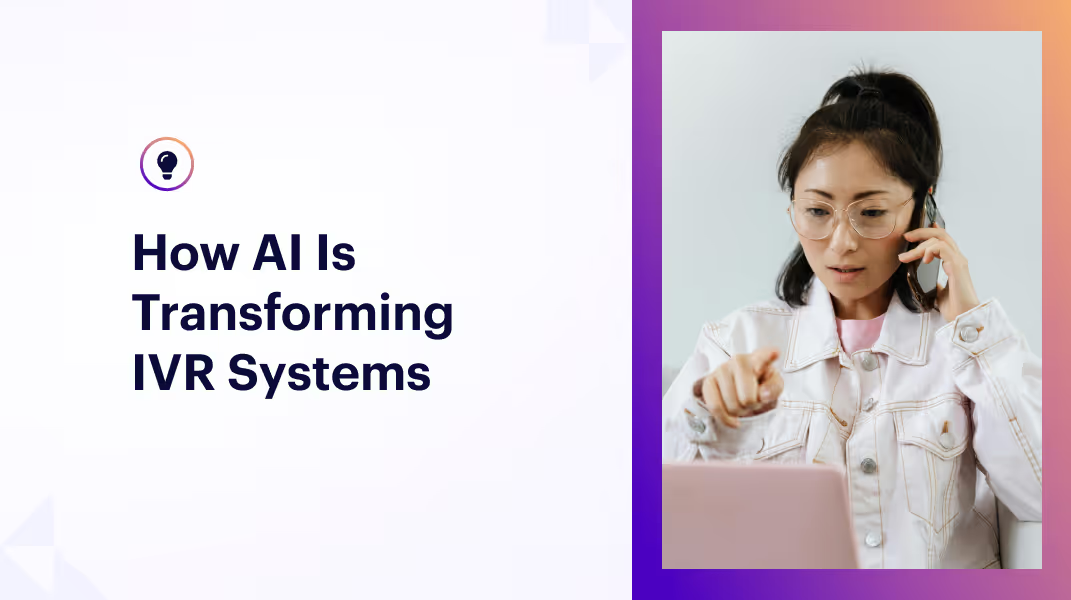Interactive voice response (IVR) software changed how enterprises manage phone-based customer interactions. Instead of every call going straight to an agent, IVR uses call routing and speech recognition to capture details and complete basic authentication.
But legacy systems have limits. Rigid menu trees, surface-level personalization, and poor handling of complex requests frustrate customers and drag down operational efficiency.
AI-powered IVR is the next step forward. Advances in conversational AI enable dynamic, intent-driven dialogue that shortens time to resolution, improves the customer experience, and routes calls more intelligently.
What is AI-Powered IVR?
AI-powered IVR is an interactive voice response system that can interpret conversational speech and understand a caller’s context and intent. These systems use artificial intelligence (AI) technologies such as natural language processing (NLP) and machine learning (ML) to analyze spoken input. Virtual agents can then respond conversationally, answering questions directly or connecting callers to a human agent when needed.
Traditional IVR routes callers through inflexible decision trees, whether that’s “press 1 for billing” or “say support for customer support.” Natural language IVR works differently: Callers describe what they need in their own words, and AI uses that request to route calls and complete tasks with greater flexibility.
Why legacy IVR systems often fall short
Traditional IVR systems offer an efficient, cost-effective way to manage initial call routing, especially compared to having live agents handle every incoming call. But they aren’t without flaws. Legacy IVR often creates headaches for customers and operational challenges for businesses.
This shows up in a few key ways:
- Frustrating menu trees: Callers know why they’re calling, but the options rarely match their needs. They get sent to the wrong department, and frustration builds. Even simple requests can get lost in translation. IVR might mishear “customer support” or fail to recognize it, leaving callers stuck in the wrong queue.
- High abandonment rates: When customers doubt they’ll reach a solution, they hang up. High abandonment also drives up repeat calls, increasing strain on support teams.
- Limited personalization: IVR can struggle with context, funneling callers into generic categories. Transfers force customers to repeat themselves, which feels impersonal and dismissive. Over time, this erodes customer trust and loyalty.
- Difficulty managing complex or unexpected requests: Script-driven systems can only follow set paths. When callers combine tasks (“update my address and check last month’s bill”), change topics mid-call, or give details out of order, the system stalls or loops them back to the beginning.
AI-based conversational IVR software overcomes these limitations by interpreting natural language and understanding intent in ways traditional systems can’t.
The biggest benefits of AI-powered IVR systems
The market for interactive voice response systems continues to expand. One research group estimates a compound annual growth rate (CAGR) of 6.1%, driven largely by the adoption of natural language understanding (NLU) and other AI capabilities.
So what does that mean for enterprises in practice? Here are a few key benefits of AI-powered IVR.
Faster call resolution through natural language understanding
AI lets customers state their needs in their own words and interprets those requests almost instantly through NLU. In some cases, AI-powered IVR can resolve the customer query right away. If a human agent is needed, the system connects the customer to the right person and passes along the context already gathered.
By contrast, even the best-case traditional IVR experience looks like this for the caller:
- Intro message and prompts: About 20 seconds of listening.
- Voice input: Caller states a need in 5–10 seconds.
- Confirmation step: System repeats it back and asks for confirmation (10–20 seconds).
- Sub-menus: Repeat the same steps across multiple layers.
- Hold time: Wait for the next available agent.
This process often takes several minutes before hold music even begins, driving up wait times and caller frustration. AI-powered IVR avoids that maze of menus, letting customers solve their problems through conversation. The result is shorter handle time, better user experience, and less strain on the call center.
Personalized call experiences based on customer data
AI IVR systems can recognize returning callers through a phone number or other authentication factors. Advanced traditional IVR can do this too, but the difference is how the recognition is applied.
With access to customer relationship management (CRM) system data, AI can act on a recognized caller dynamically. It might offer recommendations based on purchase history, tailor greetings to make the customer feel valued, or route VIP customers to a higher level of support.
By using existing information in real time, AI IVR systems can create more personalized experiences that drive customer satisfaction and loyalty.
Smarter escalation to human agents
No customer wants to shout “REPRESENTATIVE!” at an IVR system-and agents don’t want to start a conversation with someone who’s already upset. What could have been a straightforward interaction often turns tense before it even begins.
AI IVR reduces that friction. It can recognize intent and, in some cases, even detect sentiment to determine when a customer needs human assistance. It can also identify the right department or specialist, then escalate the call seamlessly. Just as important, the systems can pass along conversation history so the agent is up to speed immediately, without asking the customer to repeat details.
24/7 self-service without growing operational costs
AI-powered IVR can resolve common customer inquiries automatically, without requiring human agents for any part of the interaction. That scalability allows enterprises to extend support around the clock, handle high call volumes, and offer reliable self-service options without adding headcount.
Beyond convenience, this approach helps manage costs. Routine requests (like checking account balances, updating information, or scheduling appointments) can be handled instantly, freeing team members to focus on more complex or urgent issues. Customers get continuous availability, while the contact center operates more efficiently and keeps costs in check.
How enterprises can implement AI-powered IVR successfully
AI-powered IVR has clear benefits, but realizing them depends on putting the right pieces in place. Enterprises can set themselves up for success by focusing on three areas during setup and implementation.
Choose a flexible, open AI platform
Some enterprise AI technology solutions operate as black boxes: You get what you get, with no visibility into how the provider makes it happen. Hosted-only systems can also create limits that don’t work well in complex, context-driven environments like customer support.
Enterprises need a platform that is flexible and open, with functionality that’s customizable, integration-ready, and able to adapt to unique business needs rather than forcing teams into rigid workflows.
Compliance is also relevant here. In industries like banking, financial services, insurance, healthcare, and telecom, regulations demand solutions that can prove compliance. For some organizations, that also means deploying on-premises rather than relying solely on the cloud.
Rasa builds enterprise-grade AI tools designed with these requirements in mind: open-source, compliant, and adaptable to your business needs. Learn more about Rasa.
Integrate IVR with CRM, ticketing, and backend systems
For AI IVR to personalize support and automate interactions effectively, it needs to connect with core business systems such as CRM, ticketing, and other backend platforms.
These integrations improve accuracy and streamline workflows, creating the context awareness needed to resolve issues quickly. When customer data flows across systems, callers receive the right help faster and with less effort.
Continuously train and optimize the assistant
AI assistants can transform customer support, but they won’t get everything right on day one. To improve performance, teams need to review real interactions regularly and update the system based on what they find.
As you roll out an AI IVR system, collect conversational analytics to track what’s working and where improvements are needed. Identify bottlenecks or recurring issues, like questions the system escalates that it should be able to resolve.
Choose a solution with conversation repair, which is the ability to handle digressions or topic changes out of the box. Every generative AI system needs refinement over time, but the core ability to stay on task is essential for long-term success.
Reimagine IVR with AI-powered conversations
Traditional IVR changed how enterprises manage calls, but its static prompts and limited flexibility are showing their age. An AI-powered IVR solution goes further, delivering faster resolutions, personalized support, and scalable self-service that enhance both customer satisfaction and contact center efficiency.
Sustaining that level of service experience requires more than a closed, one-size-fits-all platform. Enterprises need AI that is open, adaptable, and compliant with industry standards. The Rasa Platform makes this possible by combining open-source generative AI with enterprise-grade controls, creating secure, scalable assistants that grow with your business.
Ready to modernize your call experience? Connect with Rasa to explore how an AI-powered IVR solution can be tailored to your organization’s needs.






